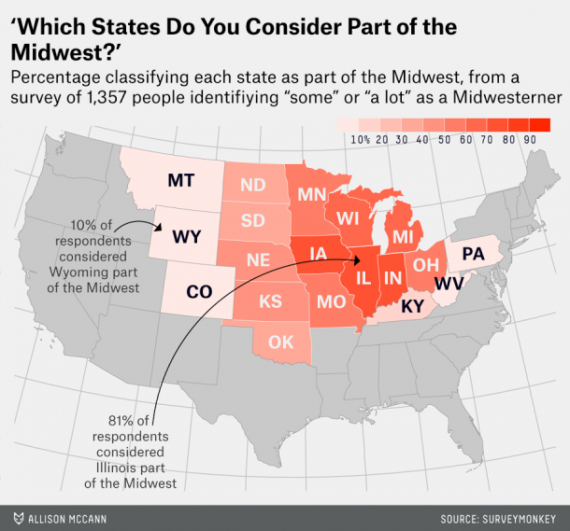Where Is The Midwest?
The American Midwest is referred to numerous times a day in political conversations, weather reports, and other such places. However, as FiveThirtyEight found, there isn’t necessarily a lot of agreement on what states make up “the Midwest”:
To get this broad-based view, we asked SurveyMonkey Audience to ask self-identified Midwesterners which states make the cut. We ran a national survey that targeted the Midwest from March 12 to March 17, with 2,778 respondents. Of those, 1,357 respondents identified “a lot” or “some” as a Midwesterner. We then asked this group to identify the states they consider part of the Midwest.
There are a lot of things here worth looking into. First, many people aren’t too sure about where the core of the Midwest is. Everybody selected at least one state for the question. But even Illinois — home of the preeminent Midwestern city, Chicago — was identified as Midwestern by just about 80 percent of respondents.
Contrast this with our soon-to-be-released Southern survey, in which people were somewhat adamant about which states make the group.
One potential, albeit anecdotal, source of this? Several self-proclaimed Midwestern sources I spoke with have a very limited definition of the Midwest: namely, their state and any state bordering it. Minnesotans thought they made up the true Midwest; Hoosiers thought they did. I can’t say either way.
Second, the potential Midwest spans further south than I thought. If half of our respondents thought Missouri and a quarter thought Oklahoma were in the Midwest, I probably should have asked about Arkansas, if only to pinpoint how far south people think the region expands. This Yankee regrets the error.
Indiana, Iowa and Illinois appear to be the core of the Midwest, each pulling more than 70 percent of the vote (that may partly be because of their substantial populations). Michigan, Wisconsin and Minnesota each pulled at least 60 percent of the vote, so we can probably put them in the Midwest without too much fuss. Ohio, Missouri and Kansas each got more than half.
As for the rest of the states, it seems unclear whether they’re in the true Midwest.
Personally, when I think of the “Midwest,” I’m thinking of Minnesota, Wisconsin, Illinois, Indiana, Ohio, Iowa, and Michigan. Missouri, I guess, would also qualify as “midewestern,” but the rest of the states here seem to me to clearly belong in other geographic groupings. Pennsylvania has traditionally been thought of as a Mid-Atlantic state, although its western border does bump up against Ohio. Kentucky and West Virginia have always been traditionally part of the south as far as I knew. The Dakotas, Nebraska, Kansas and Oklahoma? That’s the Plains States. And Montana, Wyoming and Colorado? Why anyone would think that’s part of the same “Midwest” as Ohio and Michigan is entirely behind me.







Ditto. Missouri is a transitional/hybrid state, in that St. Louis is clearly Midwestern but much of the state is more Southeast and Kansas City is the beginning of the Great Plains.
I can only tell you what I mean when I say “Midwest”. I include the old Midwest, i.e. Pennsylvania, Michigan, and Ohio, but I don’t include the border states of West Virginia and Kentucky. I also don’t include the Western states of Montana, Wyoming, and Colorado.
I also think of the Plains States (North Dakota, South Dakota, Nebraska, Kansas,and Oklahoma) as Midwestern.
It helps when certain regions have clearly-defined definitions. “West Coast” is clearly three states (although, arguably, Alaska and possibly Hawaii could also qualify.) “Gulf states” and “Atlantic seaboard” also have geography on their side. “New England” has historically been just six states. When you go beyond that, it gets fuzzy. “Appalachia?” Is Texas part of the South or the West? How much overlap is there between “the rust belt” and “the midwest?” “The South” and “the Bible Belt?”
Personally, I’ve always thought of Kansas as “Midwest,” as in generic American, whitebread, heartland kind of thing. There’s a reason that it was chosen as Superman’s native state.
And then there’s the classic exchange from “Field Of Dreams:”
“Is this heaven?”
“It’s Iowa.”
“Iowa? I could have sworn this was heaven.”
@James Joyner:
As someone who grew up in St. Louis and portions of whose family have been there since before there was a St. Louis, St. Louis has historically been the northernmost Southern city, the southernmost Northern city, the easternmost Western city, and the westernmost Eastern city.
However, today’s St. Louis is a shadow of its former self and I don’t know what it is anymore.
Huh? That’s the North, not the Midwest.
(Emphasis added for irony.)
I’m from southern Illinois originally. My personal midwest is almost defined negatively: it’s a state that isn’t part of the original colonies, isn’t part of the South, and isn’t part of the West or Southwest. I flip flop on whether the plains states are part of the Midwest or not (I also lived in Nebraska for a while). The no brainers (for me) are Ohio, Indiana, Illinois, Iowa, and Missouri.
I remember being surprised to learn as a kid that the Gateway Arch in St. Louis is officially the “Gateway to the West”. I had always assumed that Missouri was also part of the midwest; I certainly didn’t think of it as “the West”. But the arch commemorates the Louis and Clark exploration of the Louisiana Purchase, at which time it certainly was the new West.
I suspect that coasties on both coasts think of “the MIdwest” as synonymous with “flyover states”, which is how you get Wyoming nominated.
To someone who’d never thought much about the “Midwest” (I’m guessing that over 80% of Europeans have no cluse about it, for example) and who was asked to identify it on the map, I’d have thought it’s obvious why Montana, Wyoming, and Colorado might be in the Midwest. They’re half-way between the centre line of the continent and the Pacific – i.e., in the middle of the West of the US. Meanwhile, Ohio and Michigan are officially in the Midwest, when they’re not only in the Eastern half of the country (as is, I guess, the whole of the Midwest), but they’re also in the Eastern time zone!
More seriously, it would be interesting to know when the term Midwest came into common American parlance to refer to a bunch of states that are mostly on the Atlantic side of the Mississipi River. Perhaps it was back when being in Iowa meant you were already most of the way over to the frontier?
@Dave Schuler:
???
You can make an argument for Pittsburgh (and on downriver) as a little annex of the Midwest, but that’s a small part of Pennsylvania. Erie is not the Midwest; Harrisburg is not the Midwest; Philadelphia and Scranton and Lancaster are assuredly not the Midwest.
@Dave Schuler: @DrDaveT: As one who spent most of his life in either the Deep South or overseas, I’ve got a skewed sense of US geography. I reflexively think of Wisconsin and Michigan as being Northeastern and think of the Dakotas as part of the West.
Wikipedia follows the Census Bureau and says it’s Ohio and west north of the Ohio River, then the tiers including Missouri, Kansas and north.
@DrDaveT:
What I meant was the old Northwest Territory and adjacent parts of Pennsylvania.
@Dave Schuler:
Having grown up in New Jersey and spent much time in Pennsylvania due to all the family there, I can’t say I ever thought of it as part of the Midwest. Perhaps it’s one of those transitional states like Missouri?
I thought Wisconsin and Minnesota were just “Up Nort”
Another synonym for “Midwest” is “flyover country.” It’s the part of the US that doesn’t count to the Washington/New York/LA crowd.
@Nick: This. See also the location of Northwestern U., nowhere near Oregon or Washington state. I think this gets to Dave’s distinction between the old and the new.
Looking from the West, Midwest for me was NE east to IL. IN, OH, MI were great lakes states, MO and KY south.
While living in Illinois as a kid, visited northern Wisconsin. People asked where I was from, “From down South, eh?” “Illinois is a midwestern state.” “Then why does everyone from Illinois speak with a drawl?”
@DrDaveT:
Wyoming is generally considered to be part of the Northwest, along with Montana. (And then there is the Pacific Northwest, which is more easily identified as the area west of the Cascade mountains in Oregon and Washington.)
I’m from Michigan, and have always been from Michigan, and Doug’s list here is the correct one. 🙂
TBH, I think I’m largely biased by considering the traditional Big Ten, before Penn State and then the others were added, as being very midwestern. (And yes I’m aware, there’s actually a Midwestern Conference which has no bearing on my life whatsoever.)
“Midwest” is just a term I never use.
I grew up in Wisconsin and I largely agree with Doug. I frequently have arguments with a coworker about whether or not MO is the south or the Midwest. I argue it was a slave state known for BBQ and is thus the south and not the Midwest although I’m sure that can be debated as MO has been known to be incorporated into the various regions. I always thought of the midwest as midway to the “west.” That west being the old west and not the west coast, and thus the plains states are left out including Kansas and Nebraska. So shorter: Franklin is right if you look at the old Big 10.
Growing up in Minnesota, it was hard for me to think of a state two states to the right as ‘midwest’. It was some time before I could agree that Indiana was midwest…it sure looked east to me. For commercial purposes, Minnesota liked to be the center of the ‘Upper Midwest’, as the article noted, consisting of Minnesota and the four states surrounding it.
Doug’s list, plus Missouri. For the most part, if it’s west of the MIssissipi, its part of the West.
That said, there really aren’t hard and fast lines. Part of Missouri is really part of the South, and east Texas is definitely considered Southern as well.
Time to look again at Joel Garreau’s “Nine Nations of North America” where central North America , including some provinces of Canada, were simply described as “The Breadbasket.”
Doug’s list, plus Missouri. For the most part, if it’s west of the MIssissipi, its part of the West.
That said, there really aren’t hard and fast lines. Part of Missouri is really part of the South, and east Texas is definitely considered Southern as well.
Time to look again at Joel Garreau’s Nine Nations of North America where central North America , including some provinces of Canada, were simply described as “The Breadbasket.”
I think of the core of the Midwest as the Old Northwest (including Minnesota, which was only partly included), plus Iowa and the Great Plains states.
If the usage is such that one is considering most everything East of the Rockies, then it usually makes sense to treat the Great Plains states separately from the Midwest.
If we are talking about a region, and not necessarily states, I think Western Pennysylvania and the Southern Tier of New York are Midwestern. Also St. Louis is in the Midwestern region.
West Virginia, Kentucy and Missouri are border states.
I’m pretty sure that Pennsylvania is divided into thirds. The eastern third, dominated by Philly, is part of the Mid-Atlantic/Northeast. The western third, dominated by Pittsburgh, is part of the Midwest. The middle third is Northern Alabama.
@Nick: “More seriously, it would be interesting to know when the term Midwest came into common American parlance to refer to a bunch of states that are mostly on the Atlantic side of the Mississipi River. Perhaps it was back when being in Iowa meant you were already most of the way over to the frontier?”
The term originated in the 1880s in reference to post-Civil war migration. There was the Southwest (Texas and Indian territories), the Northwest (Dakotas and Montana), and between there was the Middle west (Kansas and Nebraska). The term migrated eastward, so that it included Ohio and Michigan by 1910.
Oh, so that’s the area I fly over when I go to New York. Huh. I can’t believe they bother to give it all names.
As a PA native, I can assure you we are not a Midwestern state. To be mid-western, the state must be *drum roll please* west of Pennsylvania.
From Wikipedia:
The original “Northwest Ordinance” states are the original Mid-West. (Ever hear of “Far-West Missouri”? Named so because, at the time, it was (really) “far west”.) I personally, separate the Plains States from the Midwest, but I suppose a case can be made of including some of them.
But never Pennsylvania!
@PD Shaw:
Alright, I’ll give you that one.
@Dave Schuler: I, from Illinois, once had the temerity to suggest to a native Pittsburgher that I thought Pittsburgh was a Midwestern city. I was nearly banned from the house as he clearly did not self-identify as a Midwesterner. Nonetheless, I would argue that the borders of the Midwest are better set by features other than simple state lines, e.g., the Missouri river on the west, the Appalachians on the East and the Mason/Dixon line on the South.
@John D’Geek: Line-drawing is always difficult. I looked back at the definition of Middle West given by Frederick Jackson Turner, the Sociologist of the Frontier, and he started with the proposition that in the beginning “the West” meant the other side of the Alleghenies, and the frontier moved. He seems to bound Midwest geography by Canada, the Alleghenies, the Southern Coastal Plains, and the Great Plains. He lists the conventional twelve Midwestern states though as:
Ohio, Michigan, Indiana, Illinois, Wisconsin, Minnesota, Iowa, Missouri, Kansas, Nebraska, South Dakota and North Dakota.
I think Missouri is a border state, but if you leave it out, the boundaries look artificial. But there is a reason for that, because it became a slave state, so it had different institutions (not just slave-specific), different settlers and a different economy.
@Joe: One caveat: It seems like once beyond the 100th meridian, the lack of water makes it difficult to consider the land part of the Midwest.
There is no mid-west south of the Mason Dixon line. Just not possible. As to Missouri, it is both midwestern AND southern. Get any distance south of the Missouri river and you are in the Ozarks which might as well be Appalachia. North of the Missouri River could just as well be Iowa.
Midwest is where the nice people you meet all over the world, are FROM.
The smart ones leave.
Which generally explains how Wisconsin and Michigan now have GOP governors.
(…seriously, turn over a rock anywhere in the world, and you’ll find someone from Michigan)
@OzarkHillbilly: If you extend the Mason Dixon line straight west, it will go through Missouri somewhere near Hannibal, where Mark Twain enlisted with Confederate volunteers. (I’d make a similar observation about Illinois — the Southern half is below the Mason-Dixon line)
Missouri is strange though. Most of the slave plantations were to the North of the Missouri River, in the Little Dixie region. On the other hand, its my understanding that the mining regions of the Ozarks (around Iron County) were staunchly pro-Union, and seem to resemble the types of mining communities one would find in Pennsylvania, or as you say, West Virginia. “Mountainous” regions probably deserve their own place.
@Motopilot:
By whom? That’s a new one on me. Certainly not by anyone who lives in the actual Northwest (e.g. Washington, Oregon, extreme northern California, possibly Idaho).
My wife’s family lived in Wyoming for a few decades, back in the 19th century. They consider Wyoming to be part of the “mountain West”.
@Motopilot:
Maybe the mountain West along with Colorado, but not the NorthWest.
@Nick: I think you are the winner in terms of a reasonable explanation of the “why” regarding Midwest. Back when dinosaurs ruled the earth (and man walked side by side with them) I was taught about the now “Midwestern” states being thought of as the Northwest (think Northwestern University) back in the early days of the country. As the coast became settled and taken by force from Mexico, Seattlites, Portlanders, Angelinos, and such lived in the Far West, and people in Chicago and such lived in the Midwest.
@Just ‘nutha’ ig’rant cracker: By the way, in our geography books, Montana, Wyoming, Colorado, and Utah were called “the Mountain States.” Arizona and NM were “the Southwest,” and Nevada was just itself.
What he said @Nick:
@PD Shaw: Damn, learn something new every day (I really should have known this) For some reason i always thought the M-D line was the Northern border of Tennessee and North Carolina.
@OzarkHillbilly: As a native Marylander, the M-D line is the border between Pennsylvania and Maryland (and between Delaware and Maryland, although nobody seems to care about that part of the line). And back in the day, Maryland was considered a southern state – it was a slave state all the way until the Civil War.
When I was growing up in the Middle Atlantic states, anything west of the Mississippi wasn’t considered Midwestern, apparently being part of “the West”. I agree that most of southern Missouri is really part of the South (with a bit of the Southwest thrown in) – and that’s true of Illinois as well. There’s a region in extreme southern Illinois called the “Illinois Ozarks” and if you visit there, you can see why. It’s very hilly and thickly forested.
@OzarkHillbilly: To be clear, the Mason-Dixon line stops at the Ohio River, but it can be useful to extend the line to get an idea of places Southerners probably settled. In particular, Scots-Irish from the border south settled along the North side of the Ohio River valley and were given the nicknames Buckeyes, Hoosiers and Butternuts. All of them tended to stop where the Prairie began, probably because their farming method relied upon clearing woodland and they didn’t know how to till deep turf.
@Electroman: IIRC, Thomas Jefferson viewed Virginia as a middle colony, not part of the South.
@Jenos Idanian #13: Yep. And it even has an official state religion now.
@PD Shaw: Virginia was a slave state. To me, that means it’s part of the South. I realize there’s some iffiness in that definition, in that Missouri and Texas were also slave states.